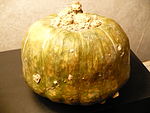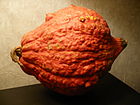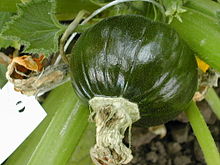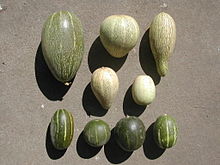- Cucurbita maxima
-
Buttercup squash 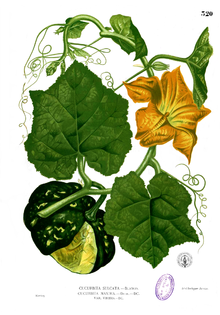
Scientific classification Kingdom: Plantae (unranked): Angiosperms (unranked): Eudicots (unranked): Rosids Order: Cucurbitales Family: Cucurbitaceae Genus: Cucurbita Species: C. maxima
DuchesneBinomial name Cucurbita maxima Subspecies [1] - C. maxima subsp. andreana
- C. maxima subsp. maxima
Cucurbita maxima, one of at least five species of cultivated squash, is one of the most diverse domesticated species, perhaps with more cultivated forms than any other crop.[2] This species originated in South America from the wild C. maxima ssp. andreana over 4000 years ago.[3] Different squash types of this species were introduced into North America as early as the 16th century. By the American Revolution, the species was in cultivation by Native American tribes throughout the present-day United States. By the early 19th century, at least three varieties are known to have been commercially introduced in North America from seeds obtained from Native Americans. Secondary centers of diversity include India, Bangladesh, Burma, and possibly the southern Appalachians.
Banana squash has an elongated shape, with light blue, pink or orange skin and bright orange flesh.
Buttercup squash is one of the most common varieties of this winter squash, with a turban shape (a flattish top and dark green skin), weighing three to five pounds, and normally heavy with dense, yellow-orange flesh.
Jarrahdale pumpkin is a pumpkin with gray skin. It is nearly identical to 'Queensland Blue' and 'Sweet Meat' varieties.
Kabocha is a Japanese variety.
Lakota squash is an American variety.
Arikara squash is an heirloom variety of C. maxima. Fruits weigh from four to eleven pounds. The shape of the fruit can be tear-drop or round, and they are colored in a mottled orange and green pattern. It is desired both for its eating qualities and as a seasonal decoration. This variety traces its ancestry to the Arikara tribe of the Dakotas, among whom its cultivation predates white settlement.
Hubbard squash is another cultivar of this species that usually has a tear-drop shape. They are often used as a replacement for pumpkins. According to one source,[4] the name comes from Bela Hubbard, settler of Randolph Township, Ohio in the Connecticut Western Reserve. Many other sources list an alternate history.[5][6] These sources state the hubbard squash (at the time nameless) came to Marblehead, Massachusetts through Captain Knott Martin. A woman named Elizabeth Hubbard brought the fruit to the attention of her neighbor, a seed trader named James J. H. Gregory. Mr. Gregory subsequently introduced it to the market using Mrs. Hubbard's name as the eponym. Gregory later bred and released the blue hubbard, which has a bluish-gray skin. The other major variety, the golden hubbard squash, has a bright orange skin. Gregory advertisements for the squash date from at least 1859.[7] The hubbard squash, including questions regarding the name, is even the subject of a children's ditty, "Raising Hubbard Squash in Vermont".[8]
The Candy Roaster landrace was originally developed by the Cherokee people in the southern Appalachians. Another heirloom variety, it is quite variable in size (10-250+ lbs), shape (round, cylindrical, teardrop, blocky, etc.), and color (pink, tan, green, blue, gray, or orange), yet most have fine-textured orange flesh. This variety enjoys continued popularity, particularly in the southern Appalachians.
Uses
Buttercup squash can be roasted, baked, and mashed into soups, among a variety of filler uses, much like pumpkin. It is extremely popular, especially as a soup, in Brazil and Africa.
All giant pumpkins (100+ lbs) are of this species, including the largest pumpkins ever documented, which have attained a size of over 1750 lbs.
The Tamil in Sri Lanka call it parangkikkaay and use to prepare dishes. But in Siddha medicine, it also used as a medicinal plant. For example, the seeds of Cucurbita maxima are fried in oil and and ground to powder form, mixed with an equal amount of sugar. The blend, and castor oil with hot water are used as a treatment for tapeworms.[verification needed]
Subspecies, cultivars and varieties
Main article: List of gourds and squashesThe Systax database at the University of Ulm lists the following subspecies:[1]
- Cucurbita maxima Duchesne (including variety 'Queensland Blue' et al.)
- C. maxima Duchesne ssp. andreana (Naudin) Filov
- C. maxima Duchesne ssp. maxima (including varieties 'Golden Delicious', 'Hubbard Squash', et al.)
- C. maxima Duchesne ssp. maxima convar. bananina Grebensc.
- C. maxima Duchesne ssp. maxima convar. hubardiana Grebensc. (including variety 'Golden Delicious', 'Green Hubbard', 'Hubbard's Squash', 'Yellow Hubbard' et al.)
- C. maxima Duchesne ssp. maxima convar. zapallitina Grebensc.
(includes typical cultivated form of summer squash "zapallito" popular in Argentina, Uruguay, Bolivia, Chile, Brasil)
- C. maxima Duchesne ssp. maxima convar. maxima (including varieties 'Hokkaido', 'Red Hokkaido', 'Red Kuri', 'Sweet Meat' et al.)
- C. maxima Duchesne ssp. maxima convar. turbaniformis (M.Roem.) Alef.
References
- ^ a b Systax database at the University of Ulm accessed 11 Sep 2010
- ^ Esquinas-Alcazar, J.T. and P.J. Gulick. 1983. Genetic resources of Cucurbitaceae: A global report. 1st ed. Intl. Board Plant Genet. Resour., IBPGR. Rome, Italy.
- ^ Sanjur, O.I., D.R. Piperno, T.C. Andres, and L. Wessel- Beaver. 2002. Phylogenetic relationships among domesticated and wild species of Cucurbita (Cucurbitaceae) inferred from a mitochondrial gene: Implications for crop plant evolution and areas of origin. Proc. Natl. Acad. Sci. USA 99:535-540.
- ^ Troyer, Loris C.: "Portage Pathways" p. 8, Kent State University Press, 1998
- ^ Watson, Ben: "Taylor's Guides to Heirloom Vegetables: A Complete Guide to the Best Historic and Ethnic Varieties" p. 268, 1996
- ^ "James J. H. Gregory: A Timeline of his Life", Worrell, Shari Kelley with Norma Lovett Gregory Kelley Flude, Victory Horticultural Library, SaveSeeds.org
- ^ The Horticulturalist Advertiser, May 1859, p.4 in The Horticulturist, and Journal of Rural Art and Rural Taste Volume 14
- ^ Cady, Daniel Leavens. Rhymes of Vermont Rural Life , Vermont:The Tuttle company, 1919 p. 100
- ^ Millán, R. 1945. Variaciones el zapallito amargo Cucurbita andreana y el origen de Cucurbita maxima. Rev. Arg. de Agron. 12:86-93.
Squashes and pumpkins List of pumpkin varieties Squashes Acorn squash • Big Max • Butternut squash • Cucurbita • Cucurbita maxima • Gem squash • Kabocha • Pattypan squash • Red kuri squash • Spaghetti squash • Summer squash • Winter squash • Yellow crookneck squash • Yellow summer squash • ZucchiniPumpkins 1068 Wallace • Atlantic Giant • Cucurbita • Hitlerszalonna • Prizewinner • Pumpkin chunking • Pumpkin pie • Pumpkin queen • Pumpkin soupCategories:- Squashes and pumpkins
- Cucurbitaceae
Wikimedia Foundation. 2010.


